SGAS Home Page
Conference Site
Seestadt Bremerhaven: http://www.seestadt-bremerhaven.de/
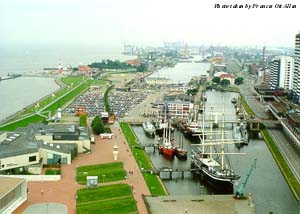 This
year for the first time, the Society for GermanAmerican Studies held its annual
conference abroad. The 24th annual symposium was held in Bremerhaven,
Germany on the theme: German emigration to America through the port of
Bremerhaven. About 200 persons attended the conference, 110 of them from
the United States.
This
year for the first time, the Society for GermanAmerican Studies held its annual
conference abroad. The 24th annual symposium was held in Bremerhaven,
Germany on the theme: German emigration to America through the port of
Bremerhaven. About 200 persons attended the conference, 110 of them from
the United States.
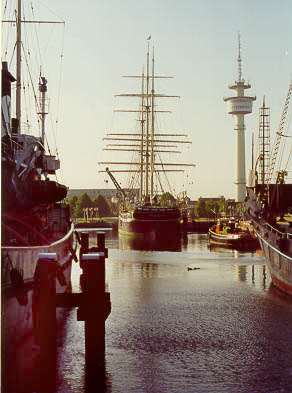 The year 2000 conference was in planning for 5
years. The spark for this came first from SGAS member, Dr. Dirk Schroeder
who has been working in GermanAmerican relations in Germany. Schroeder
convinced the SGAS Executive Committee that it was time to meet in Germany, and
especially in the port city from which millions of immigrants left for
America. In Bremerhaven the Foerderverein Deutsches Auswanderer Museum
(FDAM) was interested in cosponsoring the conference, and the planning on both
sides of the Atlantic began. Jürgen Rudloff and Horst Rössler of FDAM were
lead planners in Germany. All of the local Bremerhaven travel arrangements were
made by Wolfgang Grams of Roots to the Roots. The conference was
cosponsored and financially supported by 27 organizations and
firms.
The year 2000 conference was in planning for 5
years. The spark for this came first from SGAS member, Dr. Dirk Schroeder
who has been working in GermanAmerican relations in Germany. Schroeder
convinced the SGAS Executive Committee that it was time to meet in Germany, and
especially in the port city from which millions of immigrants left for
America. In Bremerhaven the Foerderverein Deutsches Auswanderer Museum
(FDAM) was interested in cosponsoring the conference, and the planning on both
sides of the Atlantic began. Jürgen Rudloff and Horst Rössler of FDAM were
lead planners in Germany. All of the local Bremerhaven travel arrangements were
made by Wolfgang Grams of Roots to the Roots. The conference was
cosponsored and financially supported by 27 organizations and
firms.
Usually the SGAS annual conference begins on a Thursday evening
and concludes on Sunday at noon. The year 2000 conference was lengthened
to a week, with additional related site visits available before and after the
core days of the conference.
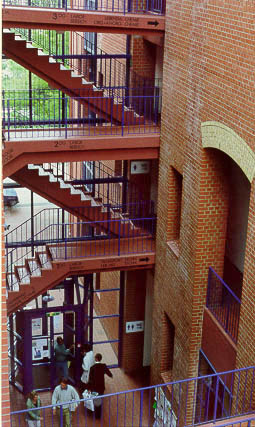 Although the conference took place in
Bremerhaven, it moved its meetings from place to place when sites relating to
the presentation were available. Most presentations took place in the
Bremerhaven Hochschule. The school's building includes what was left of
the Auswandererhaus, the old emigrant's boarding house.
Although the conference took place in
Bremerhaven, it moved its meetings from place to place when sites relating to
the presentation were available. Most presentations took place in the
Bremerhaven Hochschule. The school's building includes what was left of
the Auswandererhaus, the old emigrant's boarding house.
In the early 19th
century Bremerhaven was not a city, it was simply the dock up the river from
Bremen, where emigrants sailing to America boarded the ships. Sometimes
passengers had to wait days for their ship to sail, and there was a need for a
place for them to stay overnight, so in 1849 the Auswandererhaus was built to
solve this problem. The Auswandererhaus was described as being able to
house easily 2000 people, and served emigrants until 1865, when the new railroad
made it possible for emigrants to ride to ships quickly from
Bremen.
According to Chistina Deggim (in Vom Auswandererhaus zur
Hochschule), it was the emigrants passing through it, not those that worked
on the docks, who had nostalgic feelings for the building, because for the
latter taking leave was the daily routine. Holding conference
presentations on emigration from Bremerhaven in a building that was in part the
old emigrant boarding house added a certain ambience to the
conference.
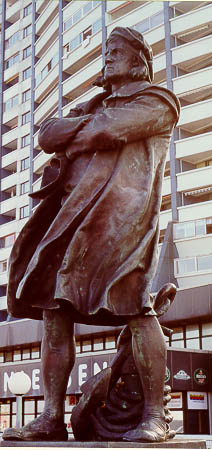 The conference began on Sunday 11 June with the traditional
evening gettogether, the "Gemuetliches Beisammensein." On Monday morning
three sessions of presentations focused on: 1) German immigration, 2)
Bremerhaven and the German emigration and 3) GermanAmerican literature.
That afternoon three more sessions were held: 4) SchleswigHolstein, which
included a paper on New Holstein, Wisconsin, 5) The German language in America,
and 6) From the Civil War to the 21st century. The latter session included
a presentation on the influence of the American Civil War on Germany, by Martin
Kuehn, a presentation on the National GermanAmerican Alliance and the
Prohibition debate, by Charles T. Johnson, and a presentation by Gert Buergel, a
TV and film producer from Dresden, who is researching the use of the name
Dresden in America in preparation for a production he plans for Dresden's 800th
anniversary celebration in 2006.
The conference began on Sunday 11 June with the traditional
evening gettogether, the "Gemuetliches Beisammensein." On Monday morning
three sessions of presentations focused on: 1) German immigration, 2)
Bremerhaven and the German emigration and 3) GermanAmerican literature.
That afternoon three more sessions were held: 4) SchleswigHolstein, which
included a paper on New Holstein, Wisconsin, 5) The German language in America,
and 6) From the Civil War to the 21st century. The latter session included
a presentation on the influence of the American Civil War on Germany, by Martin
Kuehn, a presentation on the National GermanAmerican Alliance and the
Prohibition debate, by Charles T. Johnson, and a presentation by Gert Buergel, a
TV and film producer from Dresden, who is researching the use of the name
Dresden in America in preparation for a production he plans for Dresden's 800th
anniversary celebration in 2006.
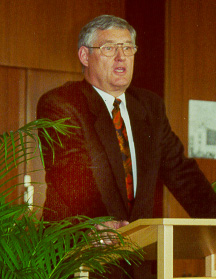 Monday evening the official welcoming
reception took place in the Weser Forum, which overlooks the old
harbor. Jürgen Rudloff, 1. Vorsitzender of the FDAM welcomed the group and
introduced Christopher Lynch, the Counsel General of the United States, who
reflected on the personal meaning of his GermanIrish ancestry. Jörg
Schulz, the mayor of Bremerhaven also welcomed the group, as did SGAS President,
Don Heinrich Tolzmann. The SGAS Award for outstanding contributions to the
field of GermanAmerican Studies was presented this year to Prof. Dr. Antonius
Holtmann, University of Oldenburg. A special award was also presented to
Dr. Dirk Schoeder, of EXPO 2000 for his work in fostering GermanAmerican
cooperation.
Monday evening the official welcoming
reception took place in the Weser Forum, which overlooks the old
harbor. Jürgen Rudloff, 1. Vorsitzender of the FDAM welcomed the group and
introduced Christopher Lynch, the Counsel General of the United States, who
reflected on the personal meaning of his GermanIrish ancestry. Jörg
Schulz, the mayor of Bremerhaven also welcomed the group, as did SGAS President,
Don Heinrich Tolzmann. The SGAS Award for outstanding contributions to the
field of GermanAmerican Studies was presented this year to Prof. Dr. Antonius
Holtmann, University of Oldenburg. A special award was also presented to
Dr. Dirk Schoeder, of EXPO 2000 for his work in fostering GermanAmerican
cooperation.
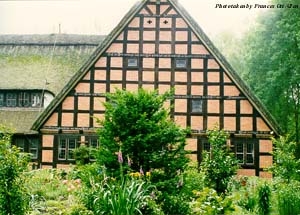 Tuesday morning the conference moved to the museum village
Cloppenburg, an open air museum containing rural north German buildings of
all kinds: from farmstead to hired hand's house, to church, to
blacksmith's shop, some dating back to the 16th century. The buildings
have been moved to large parklike grounds and are being preserved.
Interpreters who knew the group was coming were busy in several of the
farmsteads preparing a thick soup served with black bread that was the staple
meal in centuries past.
Tuesday morning the conference moved to the museum village
Cloppenburg, an open air museum containing rural north German buildings of
all kinds: from farmstead to hired hand's house, to church, to
blacksmith's shop, some dating back to the 16th century. The buildings
have been moved to large parklike grounds and are being preserved.
Interpreters who knew the group was coming were busy in several of the
farmsteads preparing a thick soup served with black bread that was the staple
meal in centuries past.
Tuesday evening a special book presentation was
hosted by the publisher Temmen to introduce Hollandgänger, Sträflinge und
Migranten: Bremen und Bremerhaven als Wanderungsraum written by Horst
Rössler. The book was carefully reviewed by Hartmut Bickelmann,
Bremerhaven city archivist; the publisher then expressed his delight in
publishing the work. Horst Rössler responded and then was toasted with
champagne.
Wednesday morning sessions focused on 7) Pennsylvania, 8) the
Ohio Valley, and 9) the FortyEighters. In these sessions the presentations
included, as example, one on Fegley's photography of the PennsylvaniaGerman
farm, one on the German aid given needy immigrants, and one on immigration to
Knox Co., Indiana. Also relating to the Ohio Valley, Giles Hoyt spoke on
the hyphen issue in Indiana. Steven Rowan described his search for details
relating to the Baron Ludwig von Reitzenstein family. Von Reitzenstein is the
author of the risque novel, The Mysteries of New Orleans, which Rowan
just recently translated into English. Annette Hofmann presented a paper
on the American Turner Society's trip to the 1880 Turnfest held in Frankfurt,
Germany.
In the afternoon the sessions were moved to Cuxhaven,
Steubenhöft. Cuxhaven was the "dock up the river" for Hamburg, as
Bremerhaven was for Bremen. In Cuxhaven in rooms where immigrants
traveling to America from Hamburg on the HAPAG line would have passed through
when boarding their ship, Elizabeth Sroka gave her presentation on the new
passenger-list database of the Hamburg Historic Emigration
Office.
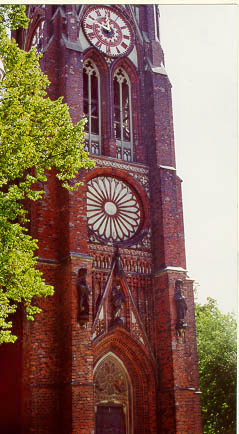 Wednesday evening Bremerhaven pastors of many denominations
provided an ecumenical church service in the large gothic Ev.-Reformed
church. Many people from Bremerhaven attended the service along with those
attending the conference. The church also hosted one of the exhibits
during the conference.
Wednesday evening Bremerhaven pastors of many denominations
provided an ecumenical church service in the large gothic Ev.-Reformed
church. Many people from Bremerhaven attended the service along with those
attending the conference. The church also hosted one of the exhibits
during the conference.
Thursday morning sessions included
11) a second session on the Ohio Valley, 12) a session held in the German
Plattdeutsch dialect, which is enjoying a revival in America, 13) The
immigration process, and 14) Texas. Those who went to session 13 saw
Diethelm Knauf's presentation,"The Norddeutsche Lloyd and the Company's image as
presented in its films." This presentation included film footage shot by poet
and writer Manfred Hausmann in 1928 while aboard ship on the way to
America. Hausmann shot many photos of steerage passengers.
Thursday
afternoon some chose to visit the Cuxland area, and others chose to visit
Bremerhaven or Bremen sites relating to migration. Inghilt Traenkle, whose
father was brought to the US after World War II as part of Operation Paperclip,
retraced steps of her childhood migration through the port of Bremerhaven.
In Sievern (Cuxland) another group visited the Johann Andreas Wagener local
history museum. Wagener had emigrated to S.C. in 1833 and played a leading
role in Charleston. He also founded Wallhalla, S.C. One of the
extensive exhibits at the conference was prepared by Helene Riley of Charleston,
S.C. on the ties between Sievern, Germany and Charleston, South Carolina.
The Cuxland visitors also saw the dykes at the water's edge, and a new wind park
where where now new style windmills are used to create
electricity.
Columbusbahnhof II was the venue for the Friday afternoon
sessions and the banquet that night. The Columbusbahnhof II is the newest
Bremerhaven pier used by emigrants. After the World War I waves of
immigrants left from the port of Bremerhaven on large oceanliners.
Columbusbahnhof II served the next wave of immigrants who left after World War
II. After the 1960's oceanliner travel gave way to air travel, and all the
noise and bustle has given way to mostly silence at this pier.
Four
members of SGAS recalled their departure from this pier after World War II and
their life in America. Ernestine Dillon's life was that of a war
bride. Ernst Schuerer desired to have the opportunity to go to the
university, so he emigrated to Canada and worked his way through school.
Dieter Sevin's immigration was an example of chain migration. Edgar
Grunwald, although German, came to the United States under the quota of
Displaced Persons from Poland, and he recounted the terrible treatment his
mother had suffered in the final stage of the war.
Besides this
interesting oral history session, GermanAmerican poets read from their
works. Ingeborg Carsten Miller read, "We the immigrants," "Das
Indianerland des 20. Jahrhunderts," and "Die Fische singen in der Nacht."
Chrisiana Seiler read her lively "In meiner Heimat bin ich nicht Tourist."
Other poets reading their works were Eddy Borchart, Horst Ludwig, and Norbert
Krapf.
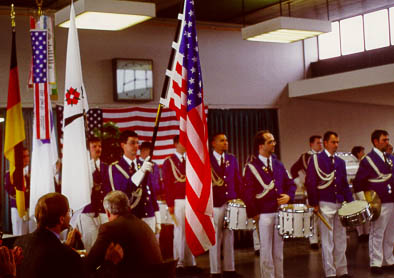 The banquet began at 6 p.m. Entertainment included the Gruppe
Schallmeyer, who played medieval music and the Rellingen band and color
guard. The Weuenwalder dance troupe wearing wooden shoes presented a
number of folk dances, and the Marinechor Blaue Jungs of Bremerhaven, who have
toured in the US, sang sailors'songs. The banquet was the final event of
the conference. The next morning several groups continued on to view sites
relating to personal interests.
The banquet began at 6 p.m. Entertainment included the Gruppe
Schallmeyer, who played medieval music and the Rellingen band and color
guard. The Weuenwalder dance troupe wearing wooden shoes presented a
number of folk dances, and the Marinechor Blaue Jungs of Bremerhaven, who have
toured in the US, sang sailors'songs. The banquet was the final event of
the conference. The next morning several groups continued on to view sites
relating to personal interests.
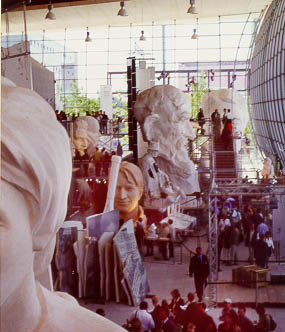 One large group chose to visit the
world's fair, EXPO 2000,
in Hannover. They had accepted the invitation for
a tour of the German Pavilion and were greeted by the Dirk Schroeder and the
German Pavilion's Director of Publicity. The German building is the
largest national exhibit. Its building has glass walls, to symbolize
national activity open to view, and the walls curve like a wave outward to
symbolize a desire to contribute to the world. Behind the glass walls
there appears to be a large sculpture workshop. Busts of thinkers and
doers and the image of work-in-progress symbolizes cerebral and physical work
done in Germany.
One large group chose to visit the
world's fair, EXPO 2000,
in Hannover. They had accepted the invitation for
a tour of the German Pavilion and were greeted by the Dirk Schroeder and the
German Pavilion's Director of Publicity. The German building is the
largest national exhibit. Its building has glass walls, to symbolize
national activity open to view, and the walls curve like a wave outward to
symbolize a desire to contribute to the world. Behind the glass walls
there appears to be a large sculpture workshop. Busts of thinkers and
doers and the image of work-in-progress symbolizes cerebral and physical work
done in Germany.
EXPO 2000 is too big to see in one day, and some
exhibits had long lines waiting to enter. The Austrian exhibit was closed
to provide security for the visiting Austrian president. The United States
chose not to be represented. Mexico's exhibit was one with long
lines. Outside, it tipped its hat to Germany by exhibiting VW Bugs built
in Mexico. One of the themes that was voiced by numerous nations was the
need to preserve the earth. The Japanese exhibit was one such; its
twostory building was constructed entirely of recycled paper. The Swiss
exhibit was built out of lumber that will be reused.
The 24th
annual SGAS meeting will be remembered by all who attended for its richness of
information and experience, and for the international ties that were
forged.
FOR FURTHER INFORMATION:
Frances Ott Allen
Publicity Director
Society for German-American Studies
Tel: 513-556-2964
E-mail: allenfo@email.uc.edu
|
Meeting Co-Sponsors
Carl-Duisberg Gesellschaft
Deutsch-Amerikanischer Club Bremen
EXPO 2000 Programm Bremen and Bremerhaven
Deutsches Schiffahrtsmuseum, Bremerhaven
Foerderverein Deutsches
Auswanderermuseum, Bremerhaven
Goethe Institut
Germans from Russia Heritage Collection
North Dakota State University
Universitaet Bremen
Forschungsstelle Niedersaechsische Auswanderer in den USA
Universitaet Oldenburg
Institut fuer Migrationsforschung und Interkulturelle Studien
Universitaet Osnabrueck
|
Return to top
SGAS Home Page
Conference Site
 Return to Max Kade/SGAS Home Page
Return to Max Kade/SGAS Home Page
Created: 16 November 1998, LDB
Updated: 17 November 2007, BAS
Comments to: IUPUI Max Kade German-American Center,
mkgac@iupui.edu
This page sponsored and maintained by IUPUI University
Libraries.
URL:
http://www.ulib.iupui.edu/kade/SGAS/sgas2000.html
|

IUPUI University Library
|

IUPUI Home Page |
 This
year for the first time, the Society for GermanAmerican Studies held its annual
conference abroad. The 24th annual symposium was held in Bremerhaven,
Germany on the theme: German emigration to America through the port of
Bremerhaven. About 200 persons attended the conference, 110 of them from
the United States.
This
year for the first time, the Society for GermanAmerican Studies held its annual
conference abroad. The 24th annual symposium was held in Bremerhaven,
Germany on the theme: German emigration to America through the port of
Bremerhaven. About 200 persons attended the conference, 110 of them from
the United States.
 The year 2000 conference was in planning for 5
years. The spark for this came first from SGAS member, Dr. Dirk Schroeder
who has been working in GermanAmerican relations in Germany. Schroeder
convinced the SGAS Executive Committee that it was time to meet in Germany, and
especially in the port city from which millions of immigrants left for
America. In Bremerhaven the Foerderverein Deutsches Auswanderer Museum
(FDAM) was interested in cosponsoring the conference, and the planning on both
sides of the Atlantic began. Jürgen Rudloff and Horst Rössler of FDAM were
lead planners in Germany. All of the local Bremerhaven travel arrangements were
made by Wolfgang Grams of Roots to the Roots. The conference was
cosponsored and financially supported by 27 organizations and
firms.
The year 2000 conference was in planning for 5
years. The spark for this came first from SGAS member, Dr. Dirk Schroeder
who has been working in GermanAmerican relations in Germany. Schroeder
convinced the SGAS Executive Committee that it was time to meet in Germany, and
especially in the port city from which millions of immigrants left for
America. In Bremerhaven the Foerderverein Deutsches Auswanderer Museum
(FDAM) was interested in cosponsoring the conference, and the planning on both
sides of the Atlantic began. Jürgen Rudloff and Horst Rössler of FDAM were
lead planners in Germany. All of the local Bremerhaven travel arrangements were
made by Wolfgang Grams of Roots to the Roots. The conference was
cosponsored and financially supported by 27 organizations and
firms.
 Although the conference took place in
Bremerhaven, it moved its meetings from place to place when sites relating to
the presentation were available. Most presentations took place in the
Bremerhaven Hochschule. The school's building includes what was left of
the Auswandererhaus, the old emigrant's boarding house.
Although the conference took place in
Bremerhaven, it moved its meetings from place to place when sites relating to
the presentation were available. Most presentations took place in the
Bremerhaven Hochschule. The school's building includes what was left of
the Auswandererhaus, the old emigrant's boarding house.
 The conference began on Sunday 11 June with the traditional
evening gettogether, the "Gemuetliches Beisammensein." On Monday morning
three sessions of presentations focused on: 1) German immigration, 2)
Bremerhaven and the German emigration and 3) GermanAmerican literature.
That afternoon three more sessions were held: 4) SchleswigHolstein, which
included a paper on New Holstein, Wisconsin, 5) The German language in America,
and 6) From the Civil War to the 21st century. The latter session included
a presentation on the influence of the American Civil War on Germany, by Martin
Kuehn, a presentation on the National GermanAmerican Alliance and the
Prohibition debate, by Charles T. Johnson, and a presentation by Gert Buergel, a
TV and film producer from Dresden, who is researching the use of the name
Dresden in America in preparation for a production he plans for Dresden's 800th
anniversary celebration in 2006.
The conference began on Sunday 11 June with the traditional
evening gettogether, the "Gemuetliches Beisammensein." On Monday morning
three sessions of presentations focused on: 1) German immigration, 2)
Bremerhaven and the German emigration and 3) GermanAmerican literature.
That afternoon three more sessions were held: 4) SchleswigHolstein, which
included a paper on New Holstein, Wisconsin, 5) The German language in America,
and 6) From the Civil War to the 21st century. The latter session included
a presentation on the influence of the American Civil War on Germany, by Martin
Kuehn, a presentation on the National GermanAmerican Alliance and the
Prohibition debate, by Charles T. Johnson, and a presentation by Gert Buergel, a
TV and film producer from Dresden, who is researching the use of the name
Dresden in America in preparation for a production he plans for Dresden's 800th
anniversary celebration in 2006.
 Monday evening the official welcoming
reception took place in the Weser Forum, which overlooks the old
harbor. Jürgen Rudloff, 1. Vorsitzender of the FDAM welcomed the group and
introduced Christopher Lynch, the Counsel General of the United States, who
reflected on the personal meaning of his GermanIrish ancestry. Jörg
Schulz, the mayor of Bremerhaven also welcomed the group, as did SGAS President,
Don Heinrich Tolzmann. The SGAS Award for outstanding contributions to the
field of GermanAmerican Studies was presented this year to Prof. Dr. Antonius
Holtmann, University of Oldenburg. A special award was also presented to
Dr. Dirk Schoeder, of EXPO 2000 for his work in fostering GermanAmerican
cooperation.
Monday evening the official welcoming
reception took place in the Weser Forum, which overlooks the old
harbor. Jürgen Rudloff, 1. Vorsitzender of the FDAM welcomed the group and
introduced Christopher Lynch, the Counsel General of the United States, who
reflected on the personal meaning of his GermanIrish ancestry. Jörg
Schulz, the mayor of Bremerhaven also welcomed the group, as did SGAS President,
Don Heinrich Tolzmann. The SGAS Award for outstanding contributions to the
field of GermanAmerican Studies was presented this year to Prof. Dr. Antonius
Holtmann, University of Oldenburg. A special award was also presented to
Dr. Dirk Schoeder, of EXPO 2000 for his work in fostering GermanAmerican
cooperation.
 Tuesday morning the conference moved to the museum village
Cloppenburg, an open air museum containing rural north German buildings of
all kinds: from farmstead to hired hand's house, to church, to
blacksmith's shop, some dating back to the 16th century. The buildings
have been moved to large parklike grounds and are being preserved.
Interpreters who knew the group was coming were busy in several of the
farmsteads preparing a thick soup served with black bread that was the staple
meal in centuries past.
Tuesday morning the conference moved to the museum village
Cloppenburg, an open air museum containing rural north German buildings of
all kinds: from farmstead to hired hand's house, to church, to
blacksmith's shop, some dating back to the 16th century. The buildings
have been moved to large parklike grounds and are being preserved.
Interpreters who knew the group was coming were busy in several of the
farmsteads preparing a thick soup served with black bread that was the staple
meal in centuries past.
 Wednesday evening Bremerhaven pastors of many denominations
provided an ecumenical church service in the large gothic Ev.-Reformed
church. Many people from Bremerhaven attended the service along with those
attending the conference. The church also hosted one of the exhibits
during the conference.
Wednesday evening Bremerhaven pastors of many denominations
provided an ecumenical church service in the large gothic Ev.-Reformed
church. Many people from Bremerhaven attended the service along with those
attending the conference. The church also hosted one of the exhibits
during the conference.
 The banquet began at 6 p.m. Entertainment included the Gruppe
Schallmeyer, who played medieval music and the Rellingen band and color
guard. The Weuenwalder dance troupe wearing wooden shoes presented a
number of folk dances, and the Marinechor Blaue Jungs of Bremerhaven, who have
toured in the US, sang sailors'songs. The banquet was the final event of
the conference. The next morning several groups continued on to view sites
relating to personal interests.
The banquet began at 6 p.m. Entertainment included the Gruppe
Schallmeyer, who played medieval music and the Rellingen band and color
guard. The Weuenwalder dance troupe wearing wooden shoes presented a
number of folk dances, and the Marinechor Blaue Jungs of Bremerhaven, who have
toured in the US, sang sailors'songs. The banquet was the final event of
the conference. The next morning several groups continued on to view sites
relating to personal interests.
 One large group chose to visit the
world's fair,
One large group chose to visit the
world's fair,  Return to
Return to 